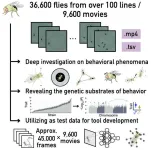(Press-News.org) COLUMBUS, Ohio – Insomnia and hazardous drinking are so closely intertwined that estimates suggest at least one-third, and as many as 91%, of people who have a hard time with sleep also misuse alcohol.
A new study suggests that perceived stress and depression factor into the relationship between the two conditions – perhaps not a surprise. But because the relationship between insomnia and heavy drinking goes in both directions, the influence of stress or depression depends on which condition came first, the analysis found.
“We were most interested in how insomnia leads to drinking, and we found that seems to occur primarily through stress. But when we switched pathways, it appeared that drinking primarily led to insomnia through depression,” said Jessica Weafer, senior author of the study and associate professor of psychiatry and behavioral health in The Ohio State University College of Medicine.
“Identifying these types of mediating factors can have important treatment implications,” she said. “If people who have insomnia are experiencing a lot of stress, then if we can target the stress, that might reduce the likelihood that their insomnia would lead to heavy drinking. That’s the long-term ideal, or hope, that this work could have an impact on treatment.”
The study was published recently in the journal Alcohol.
Insomnia and hazardous drinking can cause upheaval in one’s life: Both are associated with missed work and lower productivity on the job. Chronic insomnia can increase the risk for cardiovascular disease, Alzheimer’s and other chronic illnesses. A defining characteristic of alcohol use disorder (AUD) is continuing to drink even when encountering interpersonal problems, getting sick or hurt, or driving while intoxicated.
Weafer has expanded her research focus on risks for problem drinking to address the fact that poor sleep can lead to increased drinking and those with AUD commonly have difficulty with sleep.
“The number of people with AUD who also have insomnia is very, very high. It’s striking, and important,” she said.
Participants in this study were part of a larger project testing the effectiveness of a digital insomnia intervention for people with poor sleep who are heavy drinkers. A total of 405 volunteers completed questionnaires assessing insomnia severity, current and historic drinking behaviors, perceived stress and depression symptoms.
Stress and depression often overlap, but are distinct – the stress scale measures the degree to which situations in life are perceived as stressful, and the depression scale measures behaviors and feelings related to hope, fear, happiness and loneliness.
Previous research has suggested that stress or depression, or both, contribute to troubled sleep or heavy drinking, said first study author Justin Verlinden, a cognitive neuroscience PhD student at the University of Kentucky.
“There are so many different pathways that could explain insomnia and alcohol use. We wanted to connect the dots and see if there’s anything there,” he said.
Analyzing the data with a range of statistical models revealed the many ways stress and depression influence the relationship between insomnia and hazardous drinking.
“If you look at stress and depression separately, we find there is an indirect relationship between insomnia and drinking as well as drinking and insomnia – meaning a good chunk of the relationship between insomnia and drinking can be explained through perceived stress or depression,” Verlinden said.
“When you put both stress and depression in the same models, that’s where we get unique findings, even though there are a lot of shared characteristics between stress and depression.”
A model of insomnia predicting heavy use of alcohol showed that the characteristics of stress – beyond any symptoms shared with depression – better described this relationship. In a model reversing the order, where drinking predicts the onset of insomnia, symptoms of depression that aren’t shared with stress better explain the link.
“That finding was very surprising, but showed the benefit of looking at both stress and depression in the same model, to see how those pathways might differ depending on what the directionality is,” Weafer said.
Both stress and depression are described as partial indirect paths – meaning there are any number of other factors that could help explain the connection between bad sleep and problem drinking, the researchers said.
The findings represent a snapshot rather than explaining the progression of how insomnia and heavy drinking become linked over time, and where depression and stress fit into that evolving relationship, Weafer said. The team is collecting a final dataset that will enable the researchers to trace insomnia, stress and depression over the course of 12 months to get a better idea of the connected pathways.
The researchers are also testing the effectiveness of a digital version of cognitive behavioral therapy for insomnia called SHUTi (Sleep Healthy Using the internet) in heavy drinkers. Their December 2023 pilot study showed that SHUTi was effective at reducing insomnia in heavy drinkers – even without an emphasis on curbing alcohol use.
This research was supported by the National Institute on Alcohol Abuse and Alcoholism and the University of Kentucky.
Additional co-authors include Mairead Moloney of the University of Miami and Olga Vsevolozhskaya and Lauren Whitehurst of the University of Kentucky.
#
Contacts:
Jessica Weafer, Jessica.Weafer@osumc.edu
Justin Verlinden, Justinverlinden@uky.edu
Written by Emily Caldwell, Caldwell.151@osu.edu; 614-292-8152
END
Years of research in the field of genetics have offered interesting insights spanning the origins and development of heredity and traits, offering valuable information on its influence on every aspect of life, right from eye color to susceptibility to certain diseases. But how do our genes influence the way we act, react to threats, and interact with others? Despite the recent advances in genetics, understanding the genetic foundations of behavior remains one of biology’s most fascinating challenges. Scientists have long turned to simpler organisms to help answer these questions, with the humble fruit fly emerging as an ideal candidate. These tiny insects share ...
DARIEN, IL — The American Academy of Sleep Medicine has released a new position statement emphasizing the clinical significance of sleepiness and its impact on performance, health, mood, safety, and quality of life.
The position states that sleepiness is a critical patient-reported outcome that is associated with an increased risk for adverse health effects and diminished quality of life. The statement urges health care professionals, policymakers, and researchers to prioritize the evaluation, management, and treatment of sleepiness ...
A new USC study suggests that gut imbalances in children with autism may create an imbalance of metabolites in the digestive system — ultimately disrupting neurotransmitter production and influencing behavioral symptoms.
The research, published today in Nature Communications, adds to a growing body of science implicating the “gut-brain” axis in autism. The discovery raises the possibility of new treatment avenues. It’s an example of how research at USC, and other universities, drives ...
A new study has shed unprecedented light on the highly variable and climate-sensitive routes that substances from Siberian rivers use to travel across the Arctic Ocean. The findings raise fresh concerns about the increasing spread of pollutants and the potential consequences for fragile polar ecosystems as climate change accelerates.
The international research, published today in Nature Communications and led by the University of Bristol, in the UK, provides the clearest ever picture of how the underlying transport system, known as the Transpolar Draft, operates. It also uncovers the various factors controlling this major Arctic surface current, ...
An international team of researchers may have answered one of space science’s long-running questions – and it could change our understanding of how life began.
Carbon-rich asteroids are abundant in space yet make up less than 5 per cent of meteorites found on Earth.
An international team of scientists from Curtin University’s School of Earth and Planetary Sciences, the International Centre for Radio Astronomy (ICRAR), the Paris Observatory and more scoured the globe to find an answer.
Published today in Nature Astronomy, researchers analysed close to 8500 meteoroids and meteorite impacts, using data from ...
Statement Highlights:
While the strongest evidence exists that getting sufficient sleep (duration of sleep) is important for overall health , other components of sleep health, such as consistent bedtime, uninterrupted sleep, daytime functioning and self-reported sleep satisfaction, also contribute to cardiometabolic health and related risk factors, including heart disease, stroke, high blood pressure, high cholesterol, inflammation, glucose intolerance, obesity and obstructive sleep apnea.
Differences in sleep health may contribute to increased risk factors and worse health outcomes, particularly for people in under-resourced communities and individuals ...
Researchers from the University of Birmingham have uncovered answers that provide the detail to explain two specific DNA repair processes that have long been in question.
The publication of two papers demonstrates how work led by laboratories from the Department of Cancer and Genomic Sciences, and School of Biosciences at the University of Birmingham has made strides in understanding how the repair process is correctly orchestrated.
The importance of understanding DNA repair
Our cells protect their DNA by constantly monitoring and repairing any damage. When DNA is damaged, internal signals activate within the cell to pinpoint the damage and recruit specialised proteins—DNA ...
Microplastics and the much smaller nanoplastics enter the human body in various ways, for example through food or the air we breathe. A large proportion is excreted, but a certain amount remains in organs, blood and other body fluids. In the FFG bridge project Nano-VISION, which was launched two years ago together with the start-up BRAVE Analytics, a team led by Harald Fitzek from the Institute of Electron Microscopy and Nanoanalysis at Graz University of Technology (TU Graz) and an ophthalmologist from Graz addressed the question of whether nanoplastics also play a role in ophthalmology. The project partners have now been able to develop a method for detecting and quantifying nanoplastics ...
Rates of colorectal cancer (CRC) diagnoses dropped during and shortly after Hurricanes Irma and Maria and the COVID-19 pandemic in Puerto Rico, according to a recent analysis. However, late-stage diagnoses eventually exceeded expectations, suggesting that limited access to cancer screening services due to these disasters likely hindered timely CRC diagnoses. The findings are published by Wiley online in CANCER, a peer-reviewed journal of the American Cancer Society.
During disasters, medical services may be delayed or inaccessible due to damaged infrastructure, overburdened health ...
Sleep is a necessary part of people’s daily routine, but modern lifestyles and technology have ushered in an era of decreased rest time and subsequent fatigue. Further, the bedroom environment, such as light, sound, and temperature, is important for a good night's sleep, though this is often neglected in residential architecture.
In search of a conclusive remedy, common sleep studies use artificial light that is easy to control. Osaka Metropolitan University researchers, however, believe natural light could be more effective for re-creating actual living environments.
To test this, Graduate School of Human Life and Ecology student Xiaorui Wang and Professor ...




